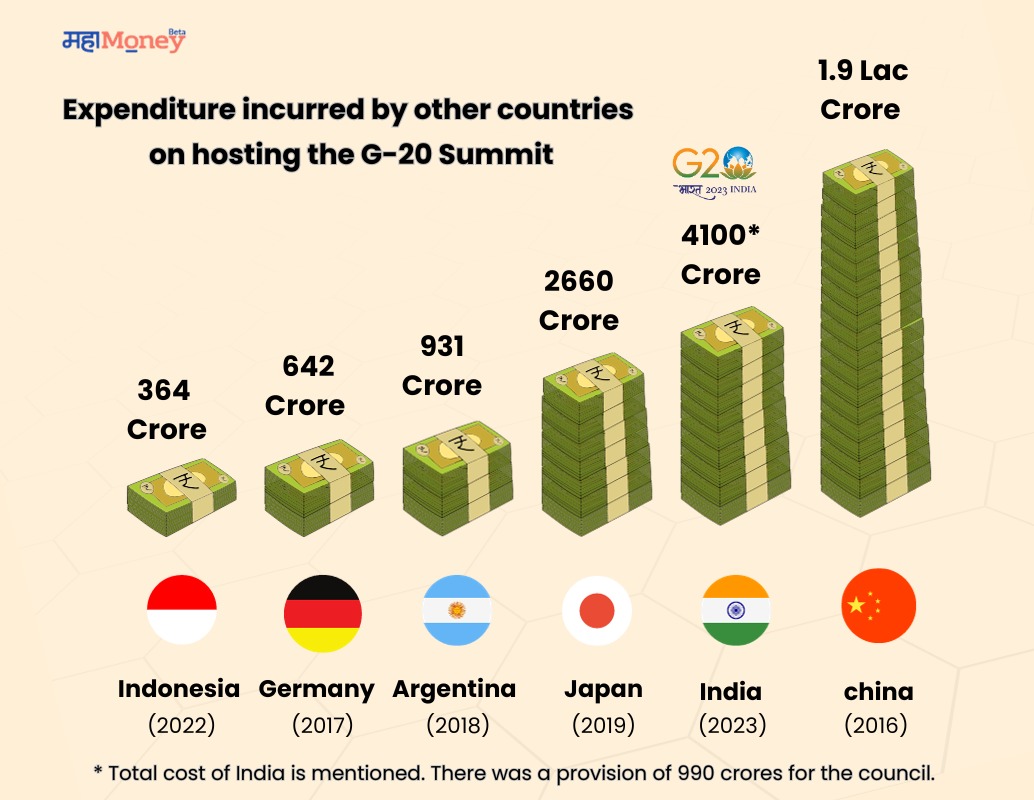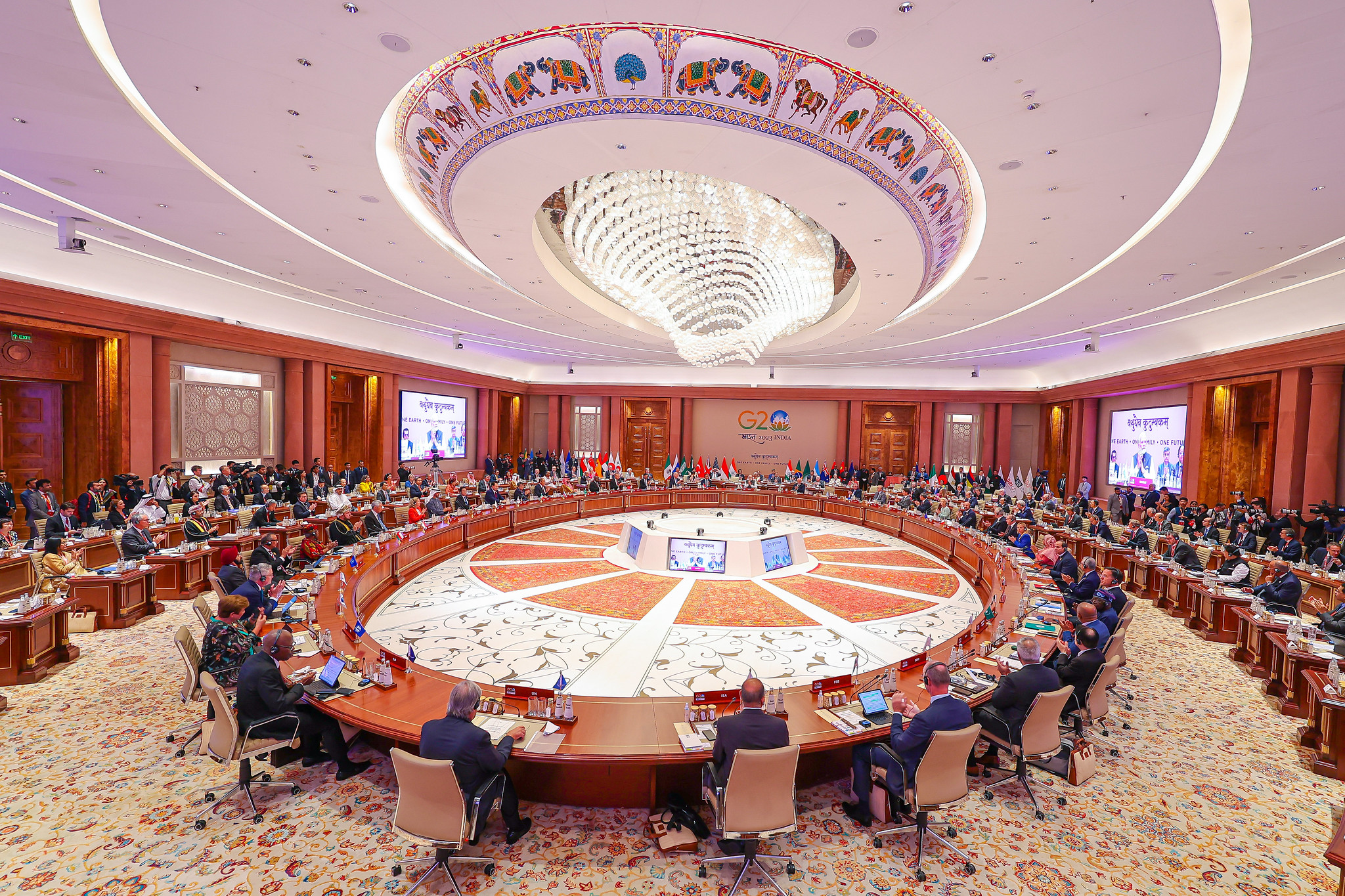Table of contents [Show]
- What is G20? Why was India hosting the G20 this year?
- What were the different events of G20 in India and their outcomes?
- What were the different expenses for G20 meetings and events?
- Did the govt really spend 300% more than what was budgeted for G20 Summit?
- What were India's tangible and intangible benefits?
What is G20? Why was India hosting the G20 this year?
The Group of Twenty (G20) is an intergovernmental forum of the world's 20 largest economies. It was founded in 1999 to respond to the financial crisis in Asia during 1997-98, with the aim of promoting global economic stability and growth.
India hosted the G20 presidency in 2023, from December 1, 2022, to November 30, 2023. This was the first time that India was hosting the G20, and it was a significant opportunity for the country to showcase its economic and diplomatic leadership on the global stage.
| G20: Key global economic cooperation platform, shaping global governance, comprising working groups, hosted by rotating presidency countries. |
India's theme for its G20 presidency was "One Earth, One Family, One Future." This theme reflected India's commitment to global cooperation and its belief that all countries are interconnected and interdependent.
The G20 presidency provided India with a platform to address some of the most challenging global issues. These included climate change, sustainable development, and global economic recovery. India also used the G20 presidency to promote its own interests, such as increasing its trade and investment with other G20 countries.
Overall, India's G20 presidency was a success. India was able to showcase its economic and diplomatic leadership on the global stage, and it was able to address some of the most pressing global challenges.

What were the different events of G20 in India and their outcomes?
India hosted over 200 events during its G20 presidency, covering a wide range of topics, including global economic governance, sustainable development, and climate change. Some of the key events included:
The G20 Leaders' Summit, was held on September 9-10, 2023 in New Delhi. The summit brought together the leaders of the G20 countries to discuss the most pressing global challenges and to coordinate their efforts to address them.
| Established in 1999 as a response to G7's limitations, the G20 includes the world's major economies, addressing concerns of restricted representation. |
The G20 Finance Ministers and Central Bank Governors Meeting was held on February 24-25, 2023 in Bengaluru. The meeting brought together the G20 countries' finance ministers and central bank governors -- this was to discuss global economic and financial issues.
The G20 Foreign Ministers' Meeting, was held on March 1-2, 2023 in New Delhi. The meeting brought together foreign ministers from the G20 countries to discuss global geopolitical issues and to promote international cooperation.
The G20 Development Working Group Meeting was held on April 21-22, 2023 in Pune. The meeting brought together experts from the G20 countries to discuss issues related to sustainable development and poverty alleviation.
| Comprising the world's leading industrialized and emerging nations, the G20 represents over two-thirds of the global population, 75% of international trade, and approximately 85% of the world's Gross National Product (GNP). This status makes it the most extensive informal assembly globally. |
The G20 Climate Sustainability Working Group Meetingand was held on May 25-26, 2023 in Kolkata. The meeting brought together G20 countries' experts who discussed climate change and environmental protection issues.
What were the different expenses for G20 meetings and events?
Detailed Breakdown of G20 India Expenses
The Indian government spent a total of ₹3600 crore (some reports claim it was over ₹4100 crore) on its G20 presidency. This included the expenses for all of the meetings and events that were held during the presidency, as well as the expenses for security, infrastructure, and logistics.
| G20 collectively constitutes 80% of the world's GDP, with BRICS nations (Brazil, Russia, India, China, and South Africa) contributing 31%, followed by the European Union (17%), the United States (16%), and the remaining G20 countries (also at 16%). |
Meetings and events
The cost of meetings and events accounted for the largest share of the G20 presidency budget, at ₹1800 crore. This included the cost of renting venues, providing food and accommodation for delegates, and organizing cultural events.
Security
The cost of security accounted for ₹600 crore of the G20 presidency budget. This included the cost of deploying police and security forces, installing CCTV cameras, and providing security for venues and transportation.
The Indian government took security very seriously during the G20 presidency, as it was hosting the leaders of some of the most powerful countries in the world. The government deployed over 100,000 security personnel to protect the G20 leaders and delegates.
Infrastructure
The cost of infrastructure accounted for ₹500 crore of the G20 presidency budget. The Indian government focused on infrastructure development investing heavily in the same, during the lead-up to the G20 presidency. This included the cost of constructing new roads, bridges, and airports, as well as upgrading existing infrastructure. This was done to ensure that the country was ready to host the G20 leaders and delegates and to provide a good impression to the rest of the world.
Some of the major infrastructure projects that were completed in the lead-up to the G20 presidency included:
- New airport terminal in New Delhi
- the upgrade of the Delhi-Agra Expressway
- The construction of new metro stations in New Delhi
- The beautification of New Delhi
| G20 nations collectively represent over 75% of worldwide trade. |
Logistics
The cost of logistics accounted for ₹700 crore of the G20 presidency budget. The Indian government had to put in place a complex logistical system to ensure the smooth running of the G20 presidency. This included transporting over 20,000 delegates to and from the meetings and events, providing food and accommodation for delegates, and managing the logistics of the security arrangements.
Rationale for the Expenses
The Indian government spent ₹3600 crore on its G20 presidency because it believed that the benefits of hosting the presidency would outweigh the costs.

Did the govt really spend 300% more than what was budgeted for G20 Summit?
Yes, the Indian government did spend 300% more than what was budgeted for the G20 Summit. The original budget for the G20 presidency was ₹990 crore, but the actual expenses ended up being around ₹3600 crore to ₹4100 crore.
| In 2015, G20 countries were responsible for 77.5% of global exports, while simultaneously receiving 76.5% of all imported goods and services. |
There are a few reasons for this increase in expenditure. First, the scope of the G20 presidency was much larger than originally anticipated. The Indian government hosted over 200 events during its presidency, which was more than any previous G20 host country. Second, the cost of security and logistics was also higher than expected. The Indian government had to deploy a large number of security forces to protect the G20 leaders and delegates, and it also had to put in place a complex logistical system to ensure the smooth running of the meetings and events.
The Indian government has defended the increased expenditure, arguing that the benefits of hosting the G20 presidency outweighed the costs. The government has pointed to the increased economic activity, improved infrastructure, and enhanced global standing that India gained from hosting the presidency.
| In 2015, China and the United States dominated global trade, ranking first. Germany secured the third position for both imports and exports. |
However, some critics have argued that the government should have been more careful with its spending, especially at a time when the Indian economy is facing a number of challenges. They have also argued that the government should have invested more in social programs and development projects, rather than spending money on hosting the G20 presidency.
Ultimately, whether or not the Indian government was justified in spending 300% more than what was budgeted for the G20 Summit is a matter of opinion. The issue has been hotly debated with both sides coming up with valid arguments.
What were India's tangible and intangible benefits?
Some of the tangible benefits of hosting the G20 presidency included:
Increased economic activity
The G20 presidency generated a lot of money due to the increased economic activity for India. This was due to the influx of foreign delegates and tourists, who boosted the hospitality, transportation, and retail sectors.
For example, the Indian government estimates that the G20 presidency generated crores in revenue for the hospitality sector alone. The transportation sector also benefited from the G20 presidency, with over 100,000 foreign delegates visiting India during the presidency.
| The G20 group does not consist of 20 countries, but 19 countries and the European Union. |
Improved infrastructure
The Indian government's investment in infrastructure development in the lead-up to the G20 presidency such as the construction of bridges, new roads, and airports will benefit the Indian economy for years to come.
These infrastructure projects will benefit the Indian economy for years to come by making it easier for businesses to operate and for people to travel around the country.
Enhanced global standing
Hosting the G20 presidency raised India's global profile and enhanced its standing in the international community. The G20 presidency was a major diplomatic achievement for India. It showed that India is a capable and responsible country that can host major international events. This will help to attract foreign investment to India and give India a greater voice in global affairs.
Intangible Benefits
In addition to the tangible benefits listed above, hosting the G20 presidency also had a number of intangible benefits for India. For example, the G20 presidency helped to boost India's national pride and morale. It also helped to raise awareness of India's culture and heritage around the world.








